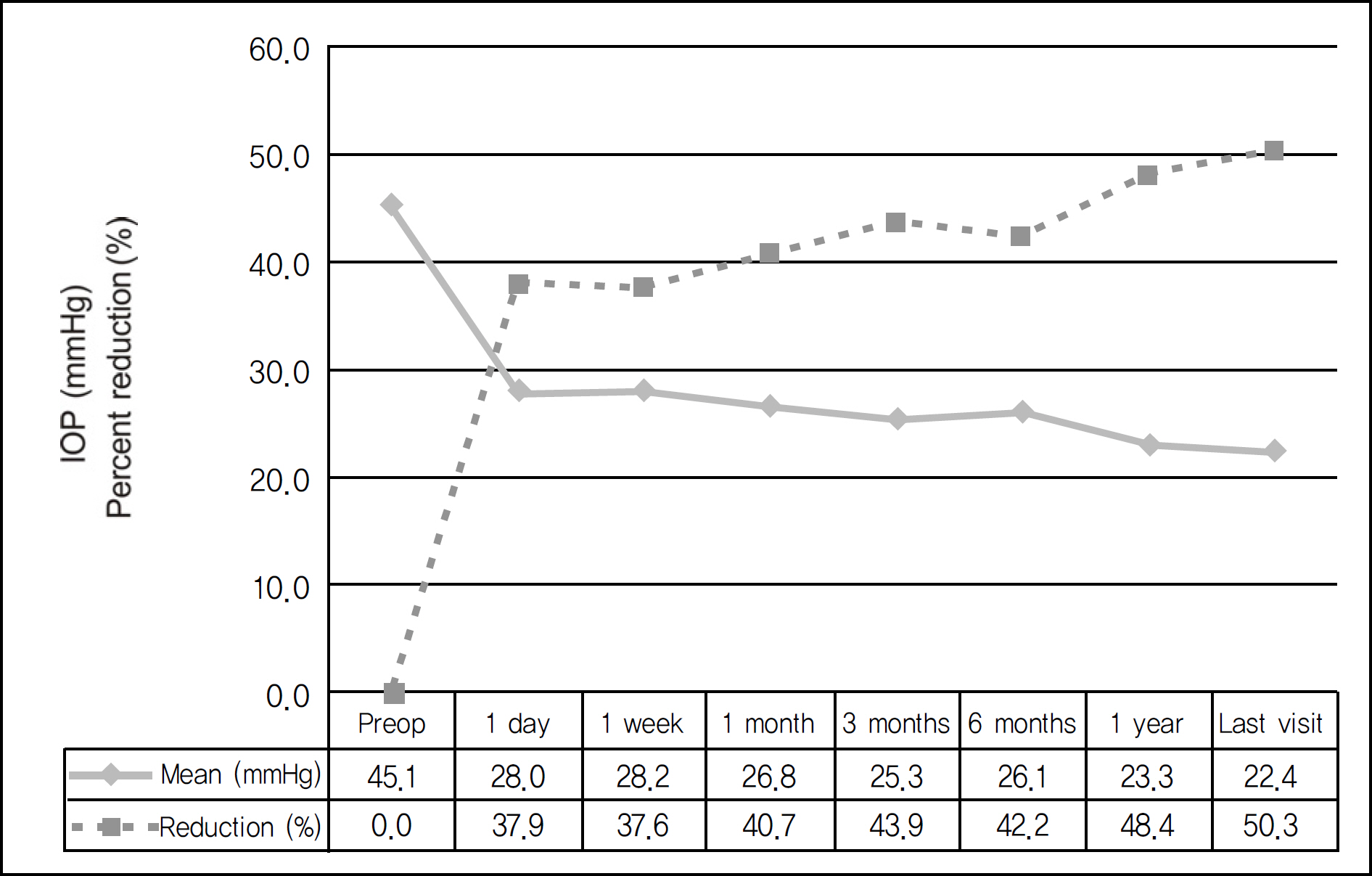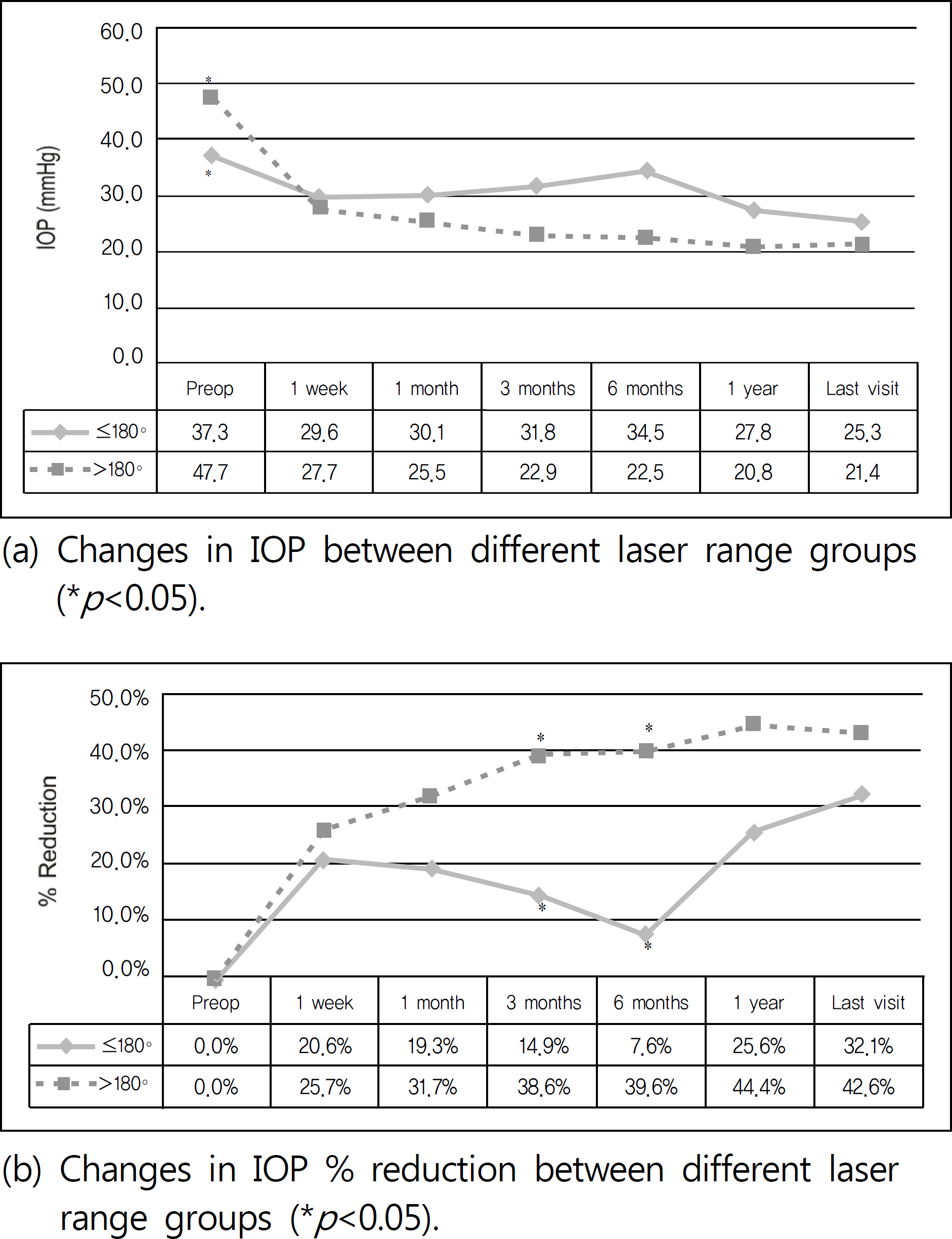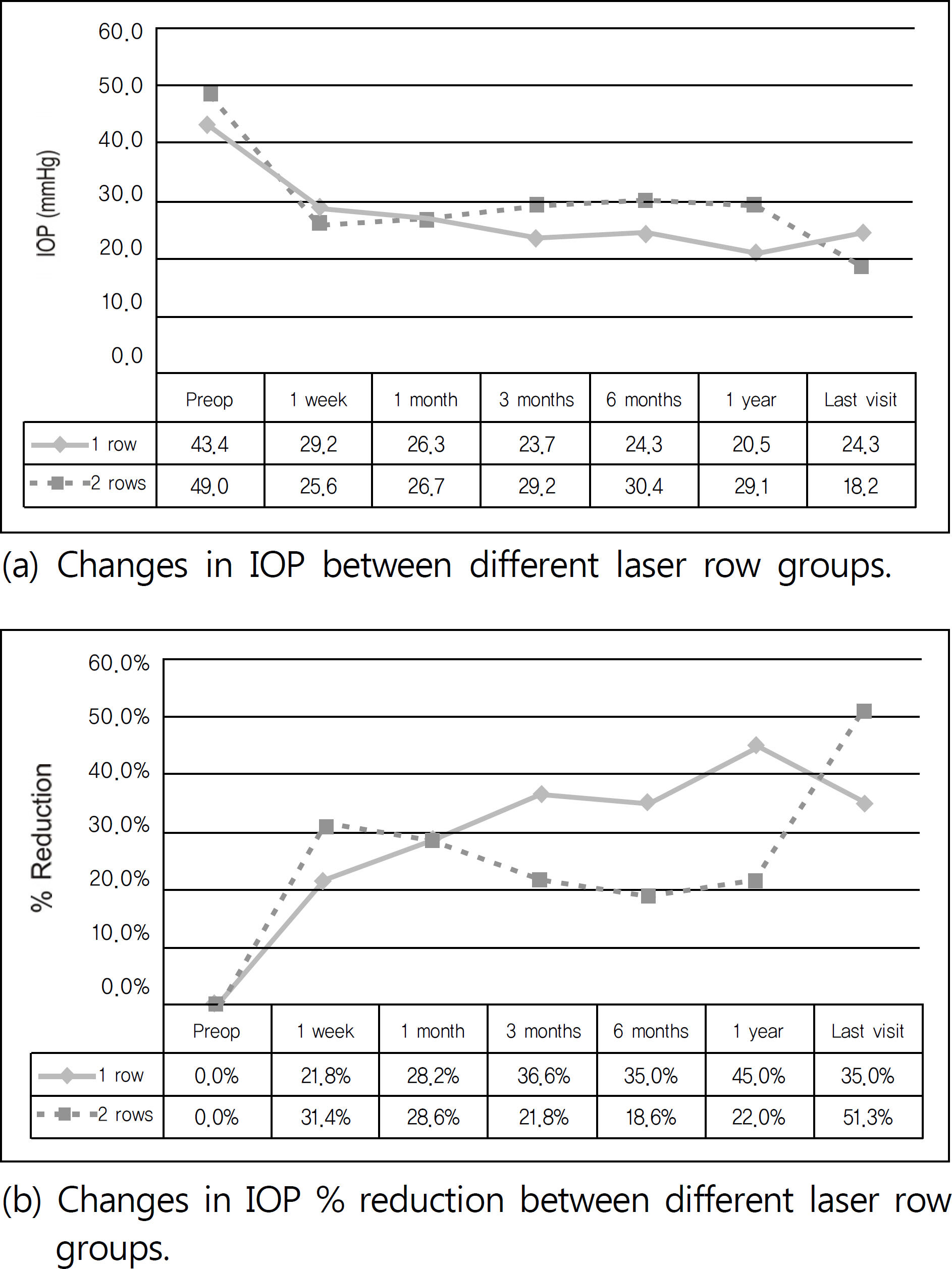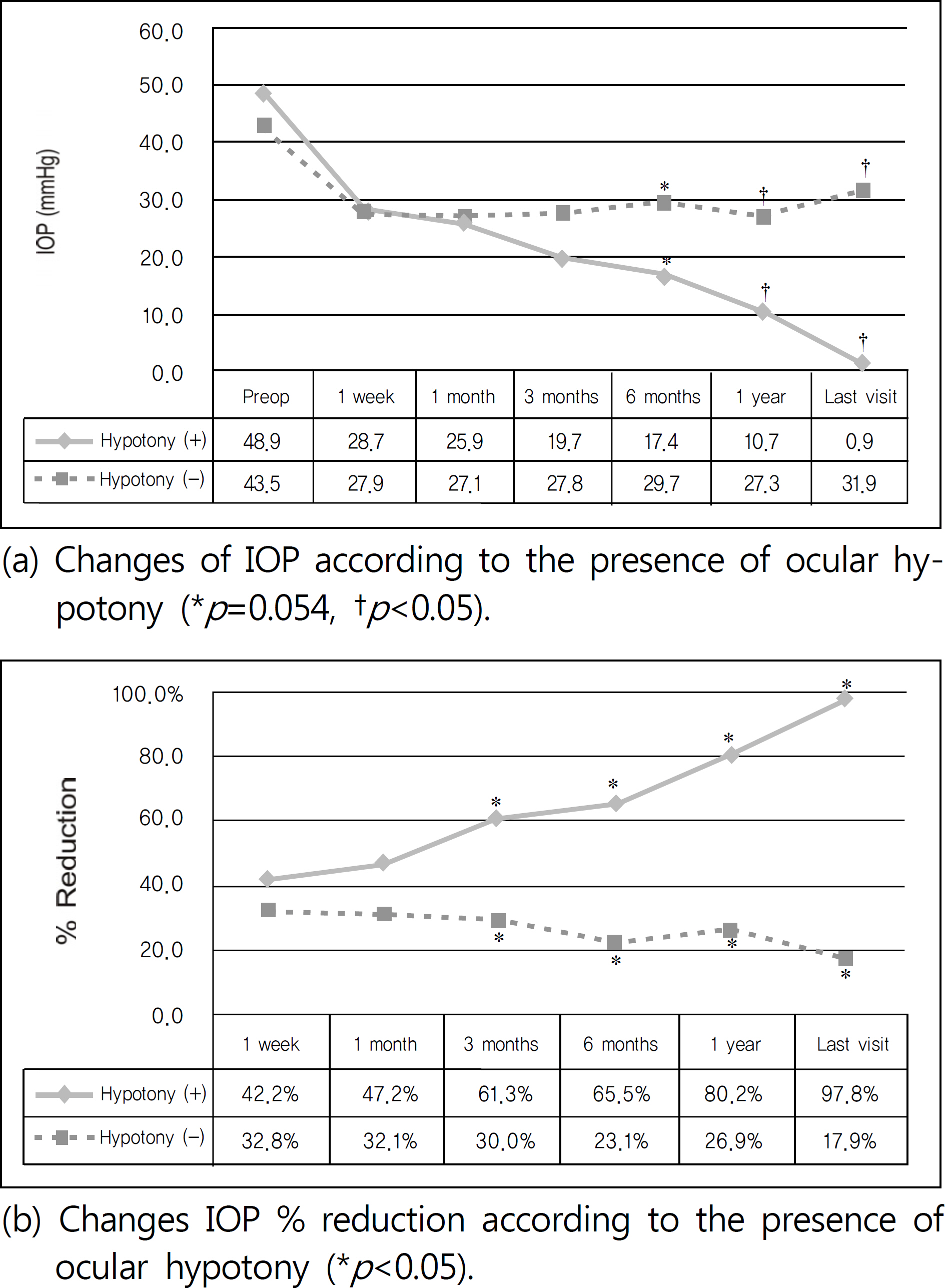J Korean Ophthalmol Soc.
2010 Jul;51(7):967-973. 10.3341/jkos.2010.51.7.967.
Influence of Application Methods on Results of Contact Transscleral Nd:YAG Laser Cyclophotocoagulation
- Affiliations
-
- 1Department of Ophthalmology, Ajou University School of Medicine, Suwon, Korea. chrisahn@ajou.ac.kr
- KMID: 2213768
- DOI: http://doi.org/10.3341/jkos.2010.51.7.967
Abstract
- PURPOSE
To examine the influence of irradiation methods on the long-term results of contact transscleral Nd:YAG laser cyclophotocoagulation and to evaluate the factors that affect changes in intraocular pressure (IOP) and occurrence of ocular hypotony after cyclophotocoagulation.
METHODS
In this retrospective study, 36 refractory glaucomatous eyes of 36 patients were observed for at least one year after a cyclophotocoagulation procedure. Contact transscleral Nd:YAG laser cyclophotocoagulation was performed with 7 to 10 Watts of power, a duration of 0.7 seconds, with one or two rows, and ranges of either greater or less than 180 degrees. The change in IOP, the success rate of the procedure, and the occurrence rate of hypotony were analyzed with regard to the methods of cyclophotocoagulation.
RESULTS
In this series of patients with refractory glaucoma, the final IOP and success rate were not significantly influenced by the laser application method or by the total energy used. The eyes with ocular hypotony showed significantly decreased IOP one year after cyclophotocoagulation when compared with eyes without ocular hypotony. The IOP percent reduction in the patients with ocular hypotony tended to decrease more rapidly than did that of the patients without hypotony, beginning three months after the operation.
CONCLUSIONS
The application methods of cyclophotocoagulation appear to have no significant influence on success rate, IOP or ocular hypotony rate. The percent reduction in IOP was higher in the hypotony group, including during the early postoperative periods.
MeSH Terms
Figure
Reference
-
References
1. Stamper RL, Liebermann MF, Drake MV. Becker-Shaffer's Diagnosis and Therapy of the Glaucomas. 8th ed.Mosby;2009.2. Allingham RR. Shields' Textbook of Glaucoma. 5th ed.Lippincott Williams & Wilkins;2005.3. Dickens CJ, Nguyen N, Mora JS, et al. Long-term results of non-contact transscleral neodymium: YAG cyclophotocoagulation. Ophthalmology. 1995; 102:1777–81.
Article4. Delgado MF, Dickens CJ, Iwach AG, et al. Long-term results of non-contact neodymium:yttrium-aluminum-garnet cyclophotocoagulation in neovascular glaucoma. Ophthalmology. 2003; 110:895–9.5. Shields MB, Shields S. Noncontact transscleral Nd:YAG cyclophotocoagulation: a long-Term follow-up of 500 patients. Trans Am Ophthalmol Soc. 1994; 92:271–87.6. Lin SC. Endoscopic and transscleral cyclophotocoagulation for the treatment of refractory glaucoma. J Glaucoma. 2008; 17:238–47.
Article7. Jin SM, Chung DY. The Effect of Contact Transscleral Nd:YAG Laser Cyclophotocoagulation in Refractory Glaucoma. J Korean Ophthalmol Soc. 2000; 41:958–64.8. Kim JB, Yang KJ. Clinical Study of Contact Transscleral Nd:YAG Laser Cyclophotocoagulation. J Korean Ophthalmol Soc. 1994; 35:1195–201.9. Pastor SA, Singh K, Lee DA, et al. Cyclophotocoagulation: a report by the American Academy of Ophthalmology. Ophthalmology. 2001; 108:2130–8.
Article10. Lin P, Wollstein G, Schuman JS. Contact transscleral neodymium: yttrium- aluminum-garnet laser cyclophotocoagulation: Long-term outcome. Ophthalmology. 2004; 111:2137–43.11. Shields MB, Wilkerson MH, Echelman DA. A comparison of two energy levels for noncontact transscleral neodymium-YAG cyclophotocoagulation. Arch Ophthalmol. 1993; 111:484–7.
Article12. Hardten DR, Brown JD. Transscleral neodymium:YAG cyclophotocoagulation: comparison of 180-degree and 360-degree initial treatments. Ophthalmic Surg. 1993; 24:181–4.
Article13. al-Ghamdi S, al-Obeidan S, Tomey KF, al-Jadaan I. Transscleral neo-dymium:YAG laser cyclophotocoagulation for end-stage glaucoma, refractory glaucoma, and painful blind eyes. Ophthalmic Surg. 1993; 24:526–9.
Article
- Full Text Links
- Actions
-
Cited
- CITED
-
- Close
- Share
- Similar articles
-
- The Effect of Contact Transscleral Nd:YAG Laser C yclophotocoagulation in Refractory Glaucoma
- Neovascular Glaucoma with Diabetic Retinopathy: Trabeculectomy and Nd:YAG Cyclophotocoagulation
- A Comparison of Cyclocryotherapy and Contact Transscleeral Cyclophotocoagulation with Diode Laser in Rabbit
- An Effects of Contact Transscleral Diode Laser Cyclophotocoagulation in Refractory Glaucoma Patients
- An Effects of Contact Transscleral Diode Laser Cyclophotocoagulation in Glaucoma Patients





